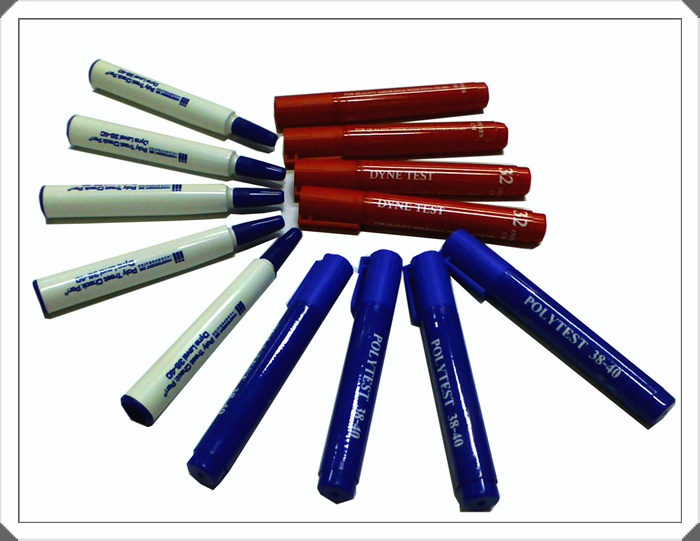ใครพอมีวิธีการตรวจสอบ Corona treat ของฟิล์มพลาสติกบ้างค่ะ
รบกวนหน่อยค่ะ
ท่านที่สมัครสมาชิกเข้ามาใหม่ กรุณารอให้ Admin ได้ทำการ Validate การเป็นสมาชิก ภายใน 24 ชม.ของวันทำการ ซึ่งระหว่างที่รอ Validation ท่านอาจจะยังไม่สามารถดาวน์โหลดข้อมูลต่างๆ ได้ หากไม่ได้รับความสะดวก กรุณาอีเมลแจ้ง isothainetwork@hotmail.com

เช็ค Corona treat ฟิล์มพลาสติก
Started by
march
, Mar 17 2012 09:46 PM
2 replies to this topic
#1

Posted 17 March 2012 - 09:46 PM
˹
#2

Posted 18 March 2012 - 08:36 PM
ผมเคยทำงานที่โรงงานพิมพ์จะใช้ Dyne Test Pens: ปากกาวัดค่าระเบิดผิว
คุณสมบัติใช้เทสผิวพลาสติก ก่อนการพิมพ์ แบ่งเป็น 2 ชนิด
- ชนิดแห้ง ขนาด 38-40 ดราย
- ชนิดน้ำ ขนาด 32 34 36 38 40 42 44 46 48 50 52 54 56 ดราย
DYNE TEST PENS Test ink for quick and reliable testing of surface tension on PE and PP. Dyne-test ink is used in the packaging industry to control that the plastic substrate has sufficient surface tension for printing, coating laminating.
To avoid having to scrap large quantities of substrate with a poor print due to insufficient bonding it is always advisable to check e.g. Corona treated material before printing.
By using a felt tipped Dyne-test pen it is easy and inexpensive to check is a substrate is ready for printing. The test itself is carried out fast and easy by simply drawing a line of blue test ink across the substrate with the pen. Whether the film has a higher or lower dyne-value than the test ink determined within the first 3 seconds after application as the line of ink either remains stable or reticulates (breaks up in to droplets).
On a partially treated substrate the test ink can also be used to control if the correct areas were treated.
Dyne test pens are supplied in dyne-values from 32-46 dyne/cm (32-46 Nm/m) in steps of 2 dyne. There are delivered complete with user instructions, and are sold singly or in sets of 4 pens with dyne-values of your own choice. General Guidelines
Referance http://www.nnptradin...c...il&conid=19
คุณสมบัติใช้เทสผิวพลาสติก ก่อนการพิมพ์ แบ่งเป็น 2 ชนิด
- ชนิดแห้ง ขนาด 38-40 ดราย
- ชนิดน้ำ ขนาด 32 34 36 38 40 42 44 46 48 50 52 54 56 ดราย
DYNE TEST PENS Test ink for quick and reliable testing of surface tension on PE and PP. Dyne-test ink is used in the packaging industry to control that the plastic substrate has sufficient surface tension for printing, coating laminating.
To avoid having to scrap large quantities of substrate with a poor print due to insufficient bonding it is always advisable to check e.g. Corona treated material before printing.
By using a felt tipped Dyne-test pen it is easy and inexpensive to check is a substrate is ready for printing. The test itself is carried out fast and easy by simply drawing a line of blue test ink across the substrate with the pen. Whether the film has a higher or lower dyne-value than the test ink determined within the first 3 seconds after application as the line of ink either remains stable or reticulates (breaks up in to droplets).
On a partially treated substrate the test ink can also be used to control if the correct areas were treated.
Dyne test pens are supplied in dyne-values from 32-46 dyne/cm (32-46 Nm/m) in steps of 2 dyne. There are delivered complete with user instructions, and are sold singly or in sets of 4 pens with dyne-values of your own choice. General Guidelines
- Use of excessive solution will result in misreading.
- Dyne Pens typically have a 6-12 month shelf life.
- The barrel of the pen is printed with the minimum dyne level that the ink will determine.
- Surface energy testing should be conducted immediately after treatment (corona, flame, and plasma).
- Treated surfaces are time sensitive and are affected by environmental conditions such as temperature and humidity.
- Do not touch or in any way contaminate the surface to be tested.
- Dirty surfaces lose their wettability; therefore you must test a clean level area.
- Do not use contaminated or outdated pens.
- Store and use pens at room temperature.
- The inks should not be exposed to direct light. Therefore keep them closed when not in use. Also, repeated ink exposure to air, will alter the dyne levels. Properly sealed pens prevent this from occurring.
- Excessive pressure will adversely affect film surface treatment levels.
Referance http://www.nnptradin...c...il&conid=19
"ในโลกนี้ไม่มีคนแปลกหน้าสำหรับเรา มีแต่เพื่อนที่เรายังไม่ได้พบกันเท่านั้น"
E-mail suppadej@gmail.com
#3

Posted 20 March 2012 - 03:08 AM
ขอบคุณมากค่ะ


˹
0 user(s) are reading this topic
0 members, 0 guests, 0 anonymous users















